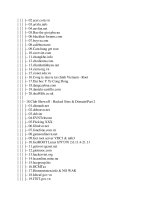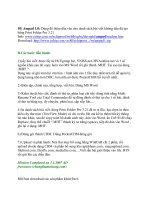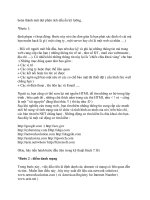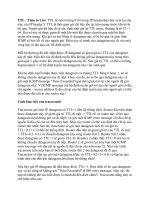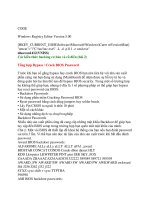Hacker Professional Ebook part 194 pps
Bạn đang xem bản rút gọn của tài liệu. Xem và tải ngay bản đầy đủ của tài liệu tại đây (20.55 KB, 6 trang )
First, it controls the export of cryptography from the U.S. (see Question
1.6); the NSA generally does not approve export of products used for
encryption unless the key size is strictly limited. It does, however,
approve for export any products used for authentication only, no matter
how large the key size, so long as the product cannot be converted to be
used for encryption. The NSA has also blocked encryption methods from being
published or patented, citing a national security threat; see Landau [46]
for a discussion of this practice. Additionally, the NSA serves an
``advisory'' role to NIST in the evaluation and selection of official U.S.
government computer security standards; in this capacity, it has played a
prominent, and controversial, role in the selection of DES and in the
development of the group of standards known as the Capstone project (see
Section 6), which includes DSS and the Clipper chip. The NSA can also
exert market pressure on U.S. companies to produce (or refrain from
producing) cryptographic goods, since the NSA itself is often a large
customer of these companies.
Cryptography is in the public eye as never before and has become the subject
of national public debate. The status of cryptography, and the NSA's role
in it, will probably change over the next few years.
8 Miscellaneous
8.1 What is the legal status of documents signed with digital signatures?
If digital signatures are to replace handwritten signatures they must have
the same legal status as handwritten signatures, i.e., documents signed
with digital signatures must be legally binding. NIST has stated that its
proposed Digital Signature Standard (see Question 6.8) should be capable
of ``proving to a third party that data was actually signed by the
generator of the signature.'' Furthermore, U.S. federal government
purchase orders will be signed by any such standard; this implies that
the government will support the legal authority of digital signatures
in the courts. Some preliminary legal research has also resulted in the
opinion that digital signatures would meet the requirements of legally
binding signatures for most purposes, including commercial use as defined
in the Uniform Commercial Code (UCC). A GAO (Government Accounting
Office) decision requested by NIST also opines that digital signatures
will meet the legal standards of handwritten signatures [20].
However, since the validity of documents with digital signatures has never
been challenged in court, their legal status is not yet well-defined.
Through such challenges, the courts will issue rulings that collectively
define which digital signature methods, key sizes, and security precautions
are acceptable for a digital signature to be legally binding.
Digital signatures have the potential to possess greater legal authority
than handwritten signatures. If a ten-page contract is signed by hand on
the tenth page, one cannot be sure that the first nine pages have not
been altered. If the contract was signed by digital signatures, however,
a third party can verify that not one byte of the contract has been altered.
Currently, if two people wish to digitally sign a series of contracts,
they may wish to first sign a paper contract in which they agree to be bound
in the future by any contracts digitally signed by them with a given
signature method and minimum key size.
8.2 What is a hash function? What is a message digest?
A hash function is a computation that takes a variable-size input and returns
a fixed-size string, which is called the hash value. If the hash function
is one-way, i.e., hard to invert, it is also called a message-digest function,
and the result is called a message digest. The idea is that a digest
represents concisely the longer message or document from which it was
computed; one can think of a message digest as a ``digital fingerprint'' of
the larger document. Examples of well-known hash functions are MD4, MD5,
and SHS (see Questions 8.3 and 8.4).
Although hash functions in general have many uses in computer programs, in
cryptography they are used to generate a small string (the message digest)
that can represent securely a much larger string, such as a file or message.
Since the hash functions are faster than the signing functions, it is much
more efficient to compute a digital signature using a document's message
digest, which is small, than using the arbitrarily large document itself.
Additionally, a digest can be made public without revealing the contents of
the document from which it derives. This is important in digital
time-stamping, where, using hash functions, one can get a document
time-stamped without revealing its contents to the time-stamping service
(see Question 3.18).
A hash function used for digital authentication must have certain
properties that make it secure enough for cryptographic use. Specifically,
it must be infeasible to find a message that hashes to a given value
and it must be infeasible to find two distinct messages that hash to
the same value. The ability to find a message hashing to a given value
would enable an attacker to substitute a fake message for a real message
that was signed. It would also enable someone to falsely disown a
message by claiming that he or she actually signed a different message
hashing to the same value, thus violating the non-repudiation property
of digital signatures. The ability to find two distinct messages hashing
to the same value could enable an attack whereby someone is tricked into
signing a message which hashes to the same value as another message with
a quite different meaning. The digest must therefore be long enough to
prevent an attacker from doing an exhaustive search for a collision. For
example, if a hash function produces 100-bit strings, exhaustive search
would take 2^{100} attempts on average to match a given value, and
approximately 2^{50} attempts on average to find two inputs producing
the same digest.
A digital signature system can be broken by attacking either the difficult
mathematical problem on which the signature method is based or the hash
function used to create the message digests. When choosing an authentication
system, it is generally a good idea to choose a signature method and a hash
function that require comparable efforts to break; any extra security in one
of the two components is wasted, since attacks will be directed at the weaker
component. Actually, attacking the hash function is harder in practice, since
it requires a large amount of memory and the ability to trick the victim into
signing a special message. With 2^{64} operations, an attacker can find two
messages that hash to the same digest under any of the MD hash functions;
this effort is comparable to that necessary to break 512-bit RSA; thus MD5 is
a good choice when using RSA with a 512-bit modulus. However, those with
greater security needs, such as certifying authorities, should use a longer
modulus and a hash function that produces a longer message digest; either SHS
(160-bit digest) or a modified version of MD4 that produces a 256-bit digest
[71] would suffice.
8.3 What are MD2, MD4 and MD5?
MD2, MD4 and MD5 (MD stands for Message Digest) are widely used hash
functions designed by Ron Rivest specifically for cryptographic use.
They produce 128-bit digests and there is no known attack faster than
exhaustive search.
MD2 is the slowest of the three; MD4 [71] is the fastest. MD5 [73]
has been dubbed ``MD4 with safety belts'' by Rivest, since it has a
more conservative design than MD4; the design gives it increased
security against attack, but at a cost of being approximately 33%
slower than MD4. MD5 is the most commonly used of the three algorithms.
MD4 and MD5 are publicly available for unrestricted use; MD2 is available
for use with PEM (see Question 8.7). Details of MD2, MD4, and MD5 with
sample C code are available in Internet RFCs (Requests For Comments)
1319, 1320, and 1321, respectively.
No feasible attacks on any of the MD algorithms have been discovered,
although some recent theoretical work has found some interesting
structural properties [24,25].
8.4 What is SHS?
The Secure Hash Standard (SHS) [58] is a hash function proposed by NIST
(see Question 7.1) and adopted as a U.S. government standard. It is
designed for use with the proposed Digital Signature Standard (see
Question 6.8) and is part of the government's Capstone project (see
Question 6.1}). SHS produces a 160-bit hash value from a variable-size
input. SHS is structurally similar to MD4 and MD5. It is roughly 25%
slower than MD5 but may be more secure, because it produces message
digests that are 25% longer than those produced by the MD functions.
SHS is currently the only part of Capstone that has been officially
adopted as a government standard.
8.5 What is Kerberos?
Kerberos is a secret-key network authentication system developed at MIT
[79]; it uses DES for encryption and authentication. Unlike a public-key
authentication system, it does not produce digital signatures: Kerberos
was designed to authenticate requests for network resources rather than
to authenticate authorship of documents. Kerberos provides real-time
authentication in a distributed environment, but does not provide for
future third-party verification of documents.
In a Kerberos system, there is a designated site on the network, called
the Kerberos server, which performs centralized key management and
administrative functions. The server maintains a database containing the
secret keys of all users, generates session keys whenever two users wish to
communicate securely, and authenticates the identity of a user who requests
certain network services.
Kerberos, like other secret-key systems, requires trust in a third party,
in this case the Kerberos server. If the server were compromised, the
integrity of the whole system would fall. Public-key cryptography was
designed precisely to avoid the necessity to trust third parties or
communication lines (see Question 1.4). Kerberos may be adequate
for those who do not need the more robust functions and properties of
public-key systems.
8.6 What are RC2 and RC4?
RC2 and RC4 are variable-key-size cipher functions designed by Ron Rivest
for fast bulk encryption. They are alternatives to DES (see Question
5.1) and are as fast or faster than DES. They can be more secure than
DES because of their ability to use long key sizes; they can also be less
secure than DES if short key sizes are used.
RC2 is a variable-key-size symmetric block cipher and can serve as a drop-in
replacement for DES, for example in export versions of products otherwise
using DES. RC2 can be used in the same modes as DES (see Question 5.3),
including triple encryption. RC2 is approximately twice as fast as DES,
at least in software. RC4 is a variable-key-size symmetric stream cipher
and is 10 or more times as fast as DES in software. Both RC2 and RC4 are
very compact in terms of code size.
An agreement between the Software Publishers Association (SPA) and the U.S.
government gives RC2 and RC4 special status by means of which the export
approval process is simpler and quicker than the usual cryptographic export
